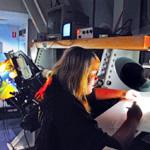Monitoring space weather effects
10 October 2012
Continuing an age-old tradition started by one of the scientific revolution forefathers—Galileo in 1612—a solar analyst sketches sunspots every morning to observe terrestrial activity at the Bureau's solar observatory in Learmonth, Western Australia.
Recording solar activity 150 million kilometres away, the Bureau's space weather services monitor and provide advice on space weather conditions that help a range of industries from radar operations to radio communications.
Why is observing space weather important?
Continuous monitoring of solar activity is vital in ensuring maximum benefit in the operation of satellites, radio, geophysics, long distance pipe lines and electricity grids.
Using an optical solar telescope, the tracking technique helps monitor:
- the sun;
- erupting filaments and prominences;
- solar flares; and
- other significant activity associated with coronal mass ejections.
As society becomes more dependent on technology, the more we utilise space—the more we're affected by space weather.
What is space weather?
Becoming a commonly used catch phrase in the 1990s, space weather refers to changes in the space environment—particularly the region between the earth and sun.
With the capability to affect the earth's upper atmosphere (including both the magnetosphere and ionosphere), huge releases of electromagnetic energy from the sun (also known as solar flares) can produce large quantities of X-rays.
Solar wind from the sun, which is streams of charged particles made up mostly of protons and electrons, can also cause changes to the earth's ionospheric conditions and magnetic field.

Left: Solar analyst sketching sunspots. Photograph by Sydney Steward. Right: Potential space weather impacts.
Concept by Bell Laboratories.
Some aspects of space weather are:
- fascinating, such as the glowing swathes of aurora;
- benevolent, and allow activities not otherwise possible such as long-range radio communications; and
- malevolent, such as HF fadeouts and ionospheric storms disrupting radio communications.


Comment. Tell us what you think of this article.
Share. Tell others.